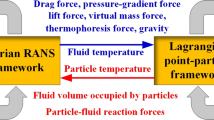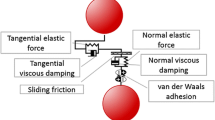Abstract
Effective removal of unwanted particles from a molten metal alloy by flotation relies on purging a gas into the melt through a rotating impeller. This device is commonly known as a rotary degasser. Unwanted particles in the melt attach to the rising gas bubbles and rise to the slag layer where they are removed from the metal bulk. In addition, the turbulence created by the rotating impeller causes the randomly distributed solid particles to agglomerate into relatively large clusters. These clusters float up or settle down due to the difference between their density and that of the melt. A mathematical model has been developed to describe the particle dynamics and particle agglomeration that occur during the rotary degassing of aluminum melts. While previous investigations addressed particle collisions in low intensity turbulent fields where the size of the colliding particles is smaller than the Kolmogorov length scale, this model is more encompassing as it considers both low intensity and high intensity turbulence. Consequently, this model is more representative of a typical industrial rotary degassing operation.
Similar content being viewed by others
Abbreviations
- A :
-
Hamaker constant
- a :
-
particle radius
- b k :
-
critical entrapment distance between bubbles and particles of size class k
- b k :
-
upper boundary volume of interval k
- C :
-
volume correction factor
- E :
-
entrapment efficiency
- g :
-
acceleration of gravity
- I v :
-
the rate of change of the volume of a particle
- n, n′ :
-
density function
- n k :
-
concentration of particles in the kth size range
- n v :
-
particle size distribution density function
- N i :
-
total number of particles in the interval i
- N T :
-
ratio between the viscous force and the Van der Waals force
- N b :
-
number of bubbles
- Q g :
-
gas flow rate
- r b :
-
average stable bubble radius
- r k :
-
average radius of particle in the kth size range
- R :
-
rate of agglomeration
- S b :
-
rate of attachment of particles to the rising gas bubbles
- S s :
-
Stokes flotation and settling rate
- S k :
-
rate of removal of particles by flotation
- S v :
-
the net rate of addition of new particles into the system
- t :
-
time
- u b :
-
bulk velocity of fluid
- Ū 2 :
-
mean squared velocity deviation of the fluid
- Ū 2 i :
-
mean squared velocity for particle i
- V :
-
volume of the melt
- υ, \(\tilde v\) :
-
unit volume of fluid
- V k :
-
average volume of the particles in size interval k
- ν b :
-
velocity difference between the bubbles and the melt
- We:
-
Weber’s number
- W v ,W:
-
rate of collision between particles
- W s :
-
Stokes collisions rate
- W t :
-
collision rate of particles caused by turbulence eddies
- α T :
-
empirical capture efficiency coefficient of collision
- β 1 :
-
ratio of the particle size to the Kolmogorov microscale
- γ :
-
fluid deformation rate
- τ p :
-
relaxation time of a particle
- ρ :
-
density
- ψ :
-
stream function
- μ :
-
viscosity of the molten metal
- ɛ :
-
energy dissipation rate
- ν :
-
kinematic viscosity of the melt
- η :
-
Kolmogorov microscale
- σ :
-
surface tension of the melt
- Δ :
-
correction coefficient
References
M. Maniruzzaman and M.M. Makhlouf: Phase Separation Technology in Aluminum Melt Treatment, American Foundrymen’s Society, Des Plains, IL, 2000.
A.G. Szekely: Metall. Trans. B, 1975, vol. 6B, pp. 259–70.
R. Gammelsæter, K. Bech, and S.T. Johansen: Light Met., 1997, pp. 1007–11.
K. Higashitani, K. Yamauchi, Y. Matsuno, and G. Hosokawa: J. Chem. Eng. Jpn., 1983, vol. 16, pp. 299–304.
K. Nakanishi and J. Szekely: Trans. Iron Steel Inst. Jpn., 1975, vol. 15, pp. 522–30.
O. Hjelle, T.A. Engh, and B. Rasch: International Seminar on Refining and Alloying of Liquid Aluminum and Ferro-Alloys, Trondheim, Norway, 1985, pp. 345–60.
B. Kulunk and R. Guthrie: Light Met., 1992, pp. 963–75.
G. Sigworth: Light Met., 2000, pp. 773–78.
E.M. Williams, R.W. McCarthy, S.A. Levy, and G.K. Sigworth: Light Met., 2000, pp. 785–93.
F. Gelbard and J.H. Seinfeld: J. Comput. Phys., 1978, vol. 28, pp. 357–75.
J.D. Landgrebe and S.E. Pratsinis: J. Colloid Interface Sci., 1990, vol. 139, pp. 63–86.
M. Frenklach and S.J. Harris: J. Colloid Interface Sci., 1987, vol. 118, pp. 252–61.
J.J. Wu and R.C. Flagan: J. Colloid Interface Sci., 1988, vol. 123, pp. 339–52.
Y. Miki, Y. Shimada, B.G. Thomas, and A. Denissov: I&SM, 1997, pp. 31–38.
M.J. Hounslow, R.L. Ryall, and V.R. Marshall: AIChE J., 1988, vol. 34, pp. 1821–38.
H. Saint-Raymond, F. Gruy, and M. Cournil: J. Colloid Interface Sci., 1998, vol. 202, pp. 238–50.
P.G. Saffman and J.S. Turner: J. Fluid Mech., 1956, vol. 1, pp. 16–30.
J. Abrahamson: Chem. Eng. Sci., 1975, vol. 30, pp. 1371–79.
S. Panchev: Random Functions and Turbulence, 1st ed., Pergamon Press, Oxford, United Kingdom, 1971.
U. Lindborg and K. Torssell: Trans. TMS-AIME, 1968, vol. 242, pp. 94–102.
T.A. Engh: Principles of Metal Refining, Oxford University Press, New York, NY, 1992, pp. 1–35.
A.N. Van and S. Kmet: Int. J. Miner. Processing, 1992, vol. 35, pp. 205–23.
M. Maniruzzaman and M. Makhlouf: Worcester Polytechnic Institute, Worcester, MA, unpublished research, 2000.
J.O. Hinze: AIChE J., 1955, vol. 1, pp. 289–95.
S.T. Johansen, S. Gradahl, P. Tetlie, B. Rasch, and E. Myrobstad: Light Met., 1998, pp. 805–10.
S.T. Johansen, R. Anvar, and B. Rasch: Light Met., 1999.
F.M. White: Fluid Mechanics, 3rd ed., McGraw-Hill, Inc., New York, NY, 1994, pp. 487–88.
M. Maniruzzaman and M. Makhlouf: Light Met., 1998, pp. 797–803.
E.E. Underwood: Quantitative Stereology, Addison-Wesley Publishing Company, Reading, MA, 1970.
Author information
Authors and Affiliations
Rights and permissions
About this article
Cite this article
Maniruzzaman, M., Makhlouf, M. Mathematical modeling and computer simulation of the rotating impeller particle flotation process: Part II. Particle agglomeration and flotation. Metall Mater Trans B 33, 305–314 (2002). https://doi.org/10.1007/s11663-002-0014-5
Received:
Issue Date:
DOI: https://doi.org/10.1007/s11663-002-0014-5




